What is PPE
PPE(personal protective equipment) refers to the variety of equipment that a person wears to protect themselves from any dangers caused by the use of tools, power tools, machinery, equipment, or the handling of materials.
General PPE
General PPE is what you see most commonly in movies or on construction sites. There are similarities between the general PPE and PPE for metal work but construction sites have a few more items. Here is a list of common PPE items you can find.
- Hard hat
- Safety harness
- Earplugs
- Reflective vest
- Safety gloves
- Safety glasses
- Overalls
- Safety shoes
- Dust mask
The PPE you need for grinding
- Overalls
- Safety shoes
- Safety glasses
- Face shield(optional)
- Earplugs
- Safety gloves
- Quality shirt
- Dust mask
You can check out my post on how to cut with an angle grinder step by step.
PPE for general metalwork
Overalls
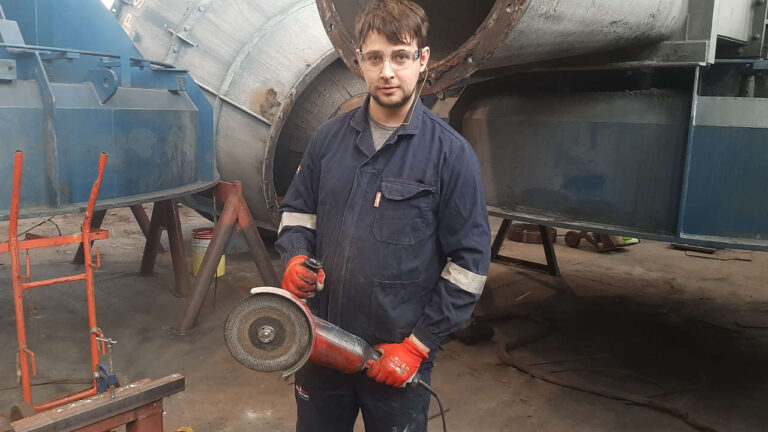
Overalls protect against minor bumps, scratches, or sharp edges that you encounter when working with metal. You should always at least wear pants overalls or you can opt for quality jeans.
Jeans that are made from a quality denim fabric will work just as well as overall pants of any sort. This is because denim is made out of cotton and treated cotton is a medium fire-resistant fabric that is good enough for metalwork.
I recommend always having long overall pants because if you drop a piece of metal, the sharp edges on the metal can cut you easily on the way down. Also when you walk past a sharp edge, the motion of your leg can cause a massive cut but the overall can help prevent this.
Safety shoes (Steel-toe)
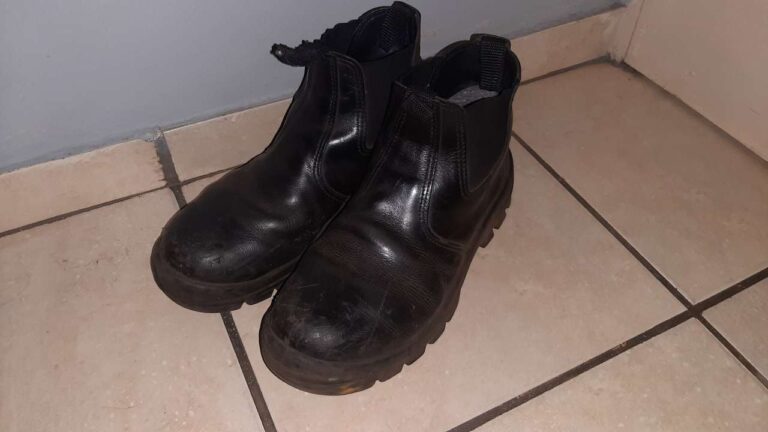
Safety shoes go without saying that if you step anywhere close to working with metal you should have them on. Dropping 4 pounds of ⅛ angle iron 3 feet will do serious damage to a barefoot or a foot in soft sneakers.
The hardened leather or rubber of a safety shoe will do a lot in protecting your feet from a ton of dangers. Personally, I have dropped heavy pieces of metal from waist high on my feet where it hits just behind the steel tip, it hurts a lot, but I never had any serious or permanent injury happen.
If you are going to work a lot with hot sparks then I recommend getting slip-on shoes. Laces tend to get burnt easily then you are left with shoes without laces. Overwise get shoes with laces because slip-on shoes tend to sit a bit looser than regular laced shoes because you can’t tighten them.
Also, do yourself a favor and polish your shoes often. This helps prevents the burning of the stitching. If your stitching gets burnt off then you will most likely have to get new shoes because sparks and shaving can easily get into your shoes and cause serious injuries. I have personally had my safety shoes that cost about $50 for a couple of years now and I polish them regularly and they just seem to last whereas others that don’t polish have to replace theirs every few months.
Safety glasses
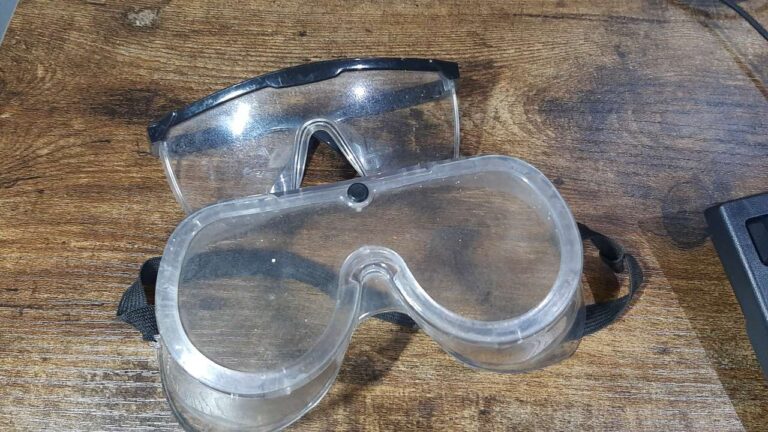
The correct thing to do is always have your safety glasses covering your eyes when entering a workshop. This is to help prevent a rogue spark from randomly entering your eye, especially if there are people around you who are using angle grinders.
This has happened to me a few times where I will be working and feel a piece of someone else’s angle grinder disc hit me on the face at a speed. This is even if the person is standing more than 10 meters away. It hurts a lot and I can just imagine if it hits you in the eye.
You should always wear safety glasses when working with any tool or machine. You don’t know when a piece will chip off and shoot back at you.
When deciding what safety glasses to get you should consider getting one that covers not just your eyes, but also the area around them. This is because while you are working a spark or shrapnel can still enter from the sides that aren’t covered.
When working with oxy-fuel cutting you should wear darkened safety glasses. It helps you to see better because the point where you cut can get a bit bright. Also, don’t use darkened safety glasses when welding they seriously aren’t enough protection.
Earplugs
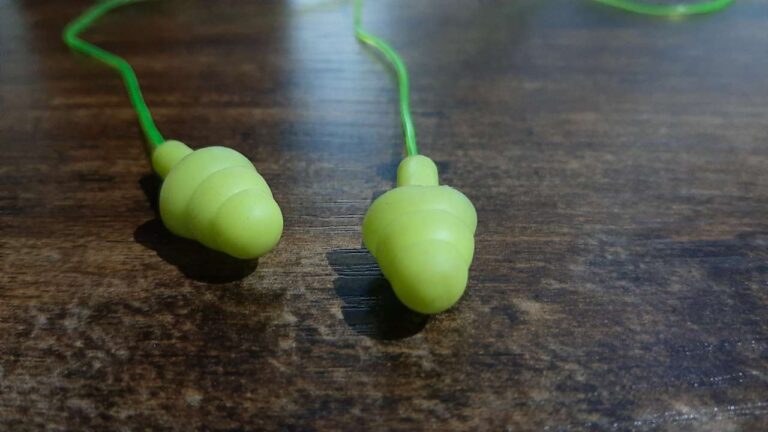
Earplugs can look different, but they all have the same end goal, preventing ear damage. For example, extensive use of an angle grinder can start to hurt your ears and if you do it for years you can get permanent hearing damage.
It is best to keep them on while you are working even if you aren’t busy grinding or using a hammer. If you aren’t busy at the moment you can remove them and keep them close. If someone close to you is using a loud machine or tool then try to keep them in.
When putting earplugs into your ears it is best to not press them in too deep. It can hurt your ears or you can push dirt deep into your ear channel. Rather just lightly press them into your ears so they sit a bit loose, so they only cover the front part of your ear channel.
Safety gloves
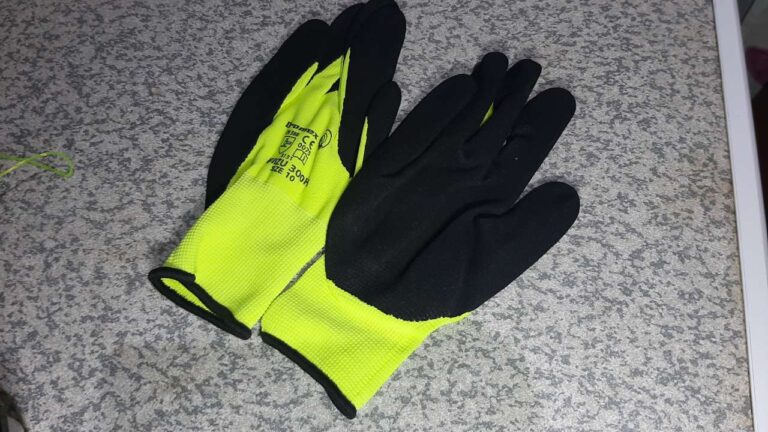
Safety gloves that are skin-tight are great because they provide extra grip, keep your hands cleaner, and help prevent most small cuts, scratches, or burns.
It does no harm to keep them on while you are working with metal, wood, or any other hard/rough material.
They act as an extra layer of skin over your hands I would say they are essential because I can personally attest to how many times they have saved me from getting burnt on hot metal. Don’t get me wrong you shouldn’t handle hot metal with these gloves, but accidentally touching hot metal happens and they do a good enough job of warning you so you can quickly pull your hand away.
Welder gloves
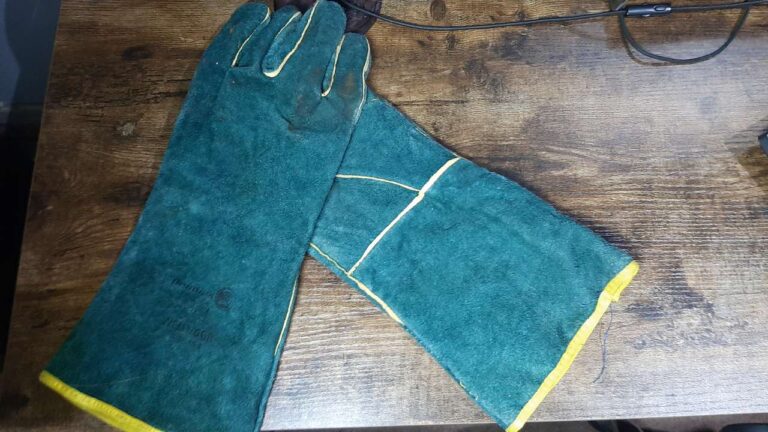
Welder gloves are thick leather gloves that help to protect you from the heat of the hot metal. Note that you still shouldn’t ever pick up or touch very hot metal with these gloves because they get hot and burn you in turn. Also, never ever touch hot metal with wet gloves because the water vaporizes immediately and the steam will burn your hand. If you find yourself burning from holding a hot piece of metal then you should immediately drop the piece and remove the glove this is because it isn’t the hot metal burning you, but the heated glove.
If you notice a small hole or rips in the gloves, throw them away and get new ones because when you are working you might forget about the hole and pick up a warm piece of metal only to burn your skin through the small hole in the glove.
Quality shirt
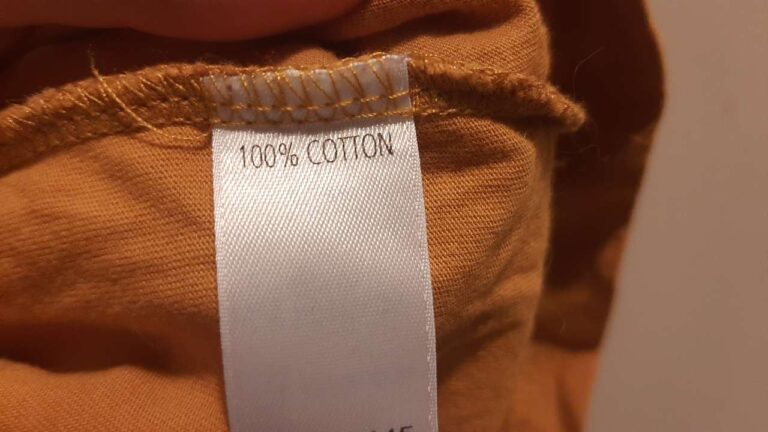
A quality work shirt should be made from 100% cotton. This is because cotton doesn’t burn as easily as mentioned in the overalls section. You don’t need to go buy a dedicated shirt for metalwork just get a shirt that says 100% cotton. It can be of any brand, size, or color.
Never use any piece of clothing that has polyester, nylon, polyamide, or acrylic in it while working with hot sparks. This is because those materials are plastics and tend to melt very easily. These materials can form large holes in your clothing, providing zero protection, or even burn to your skin.
Just remember to wear an overall jacket when welding or using an angle grinder to avoid getting “arc tan” or to prevent the sparks from burning your arms.
I dubbed the name “arc tan” because you turn red as if you have been in the sun for a long time. You should avoid this because like sunburn it can be painful.
Dust mask
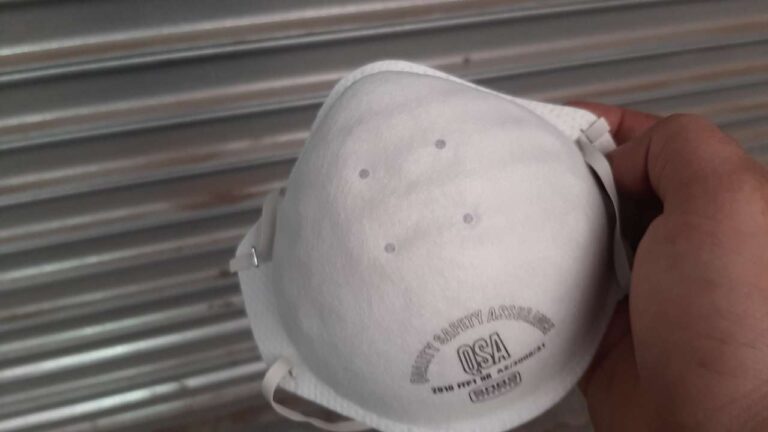
When using any equipment that kicks up dust you should wear a dust mask or dust respirator. This is just to prevent any dangers to you and to avoid any permanent damage that can be caused by the dust being kicked up.
PPE for welding
PPE for welding includes:
- Overalls
- Safety shoes
- Earplugs
- Quality shirt
- Welding gloves/ 23inch gloves
- Welding helmet
- Leather apron
- Head and neck protection
Welding helmet
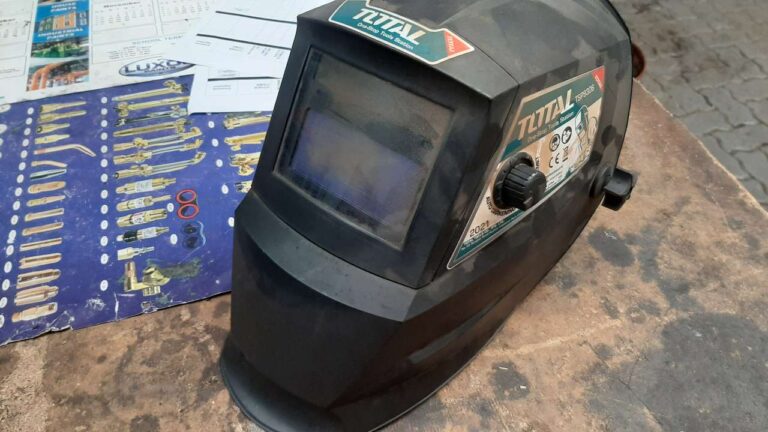
A welding helmet is used to protect your face and eyes from the bright arc that is produced when welding. It is also used so you can see where you are welding or tacking.
A darkened lens on the helmet is used to reduce the brightness of the arc so you can see where you are welding, while you weld. You can think of this lens as wearing sunglasses at night. You won’t be able to see through them in general use, but the will be able to see the weld and the area around the weld.
This is an absolute must-have when you are welding because without it you won’t be able to see anything at all. You might get away with it if you are just going to tack, but once you start moving your torch you will need to see where you are going.
Not being able to see where you weld is like drawing a box with your eyes closed, you will get the general directions but the lines will never match. That is why you might be able to go from left to right, but you will most likely completely miss your mark where you need to weld.
An auto-darkening welding helmet is great because unlike general welding helmets you don’t need to start your weld blind. You can clearly see where you need to start once you start the lens darkens and you can weld. Just be sure to not have any lag on the darkening because you can still get “arc eyes” from the bright arc.
Leather apron
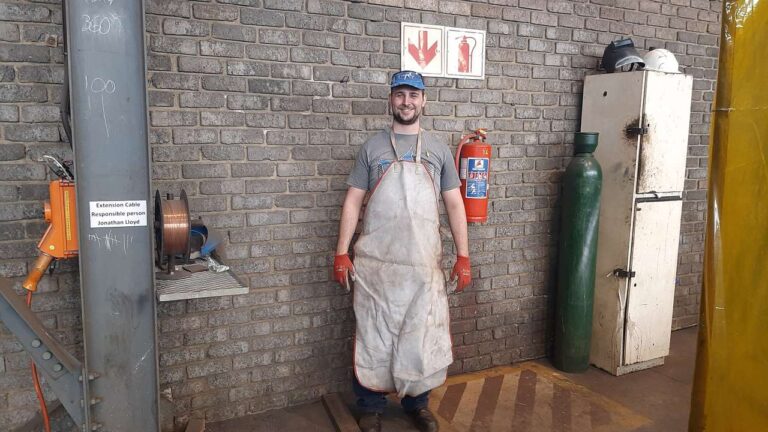
A leather apron is an additional source of protection that you wear over your overalls. This isn’t a must but does help a lot in protecting you and your clothes from hot sparks that can come from welding, grinding, or cutting.
You wear it like any sort of kitchen apron but it is a bit heavier due to the fact that it is made from leather. It does a better job of protecting you from heat but is limited to the front of your legs, your waist, and part of your chest.
Leather aprons range from basic ones that are just straps with a piece of leather in front to nice ones that strap around your shoulders and not your neck that can even come with a place to put tools. I recommend getting one that at least straps around your shoulders and not your neck because the strap around your neck can get very uncomfortable over time.
23-inch gloves
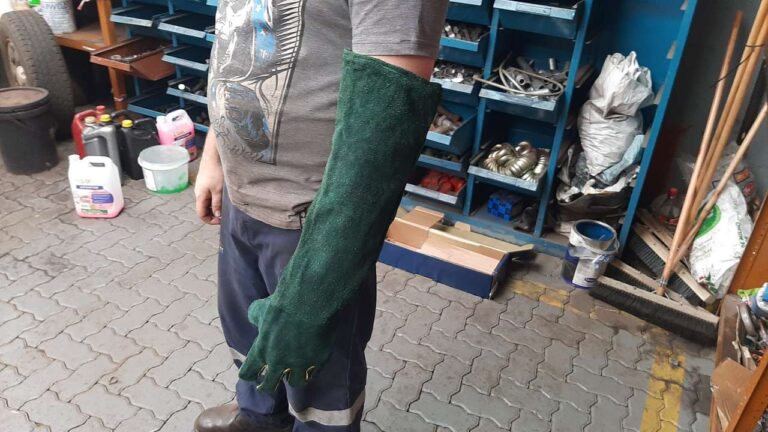
23-inch gloves are exactly like welder gloves just with a longer sleeve that goes up to your upper arm. This is to protect you from the constant barrage of sparks that tend to hit your arm. These constant sparks can easily burn through your overall sleeve and start to burn you.
It is a good idea to use these welder gloves rather than the shorter ones when welding, but for general work, the shorter gloves are better to use.
Leather aprons range from basic ones that are just straps with a piece of leather in front to nice ones that strap around your shoulders and not your neck that can even come with a place to put tools. I recommend getting one that at least straps around your shoulders and not your neck because the strap around your neck can get very uncomfortable over time.
Neck protection
You should protect your neck from the heat and arc of the welding to avoid getting an “arc tan”. You can get neck protection in different forms ranging from dedicated protection you can buy, to putting a cloth around your neck.
It might not look so appealing or even seem worthwhile, but the bright arc light can get in small areas and if a tiny part of your neck is exposed you will get burnt while welding.
Head protection
Head protection is used to keep sparks from burning the top of your head. Like all the other items I highly recommend wearing head protection even if it’s just a normal baseball hat. This is one of those items you won’t know is that useful till you go one day without it. Constant hitting of sparks on the top of your head is painful and sometimes larger and hotter ones can hit that don’t go out immediately.
You should wear your welding helmet over the head protection for optimal use.
Conclusion
You should always try to use the proper PPE for the situation to completely protect yourself from the dangers of working with metal and the heat it can produce.
Try and avoid using too much PPE for what you are doing because it can limit your mobility. For example, you might not see something in your way and trip over it because your vision was too obscured for what you are doing.
Just try to use your intuition when working with metal. If you feel it is unsafe it most likely is. Try to take a different approach to avoid the danger.

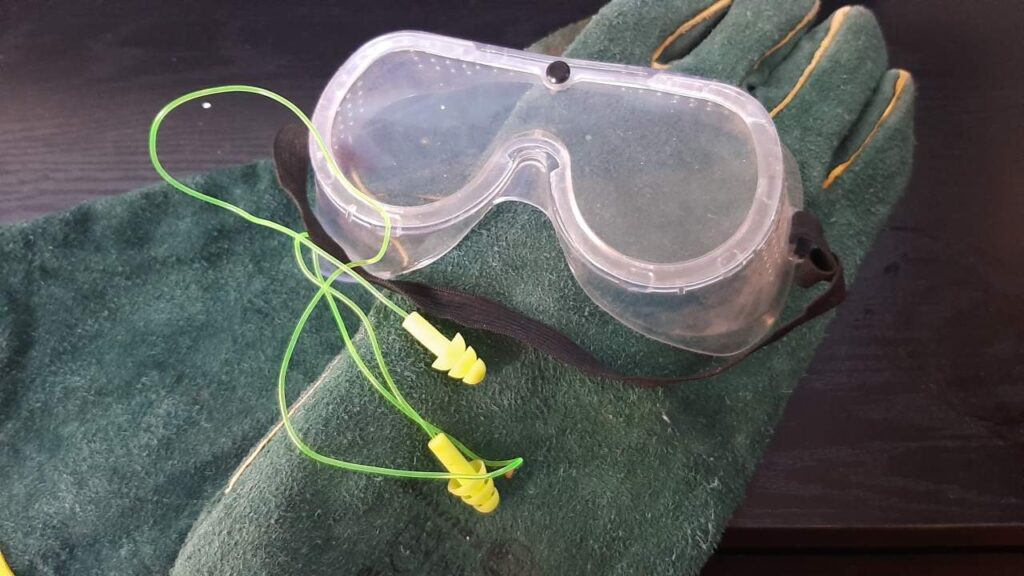
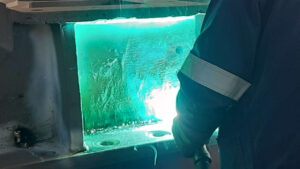
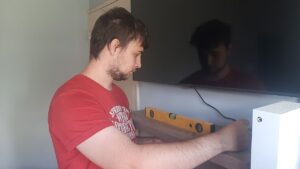
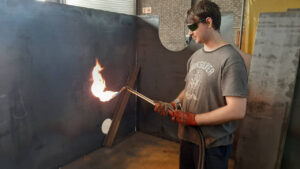

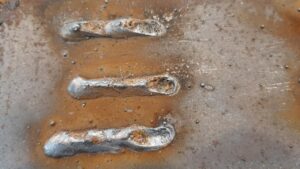
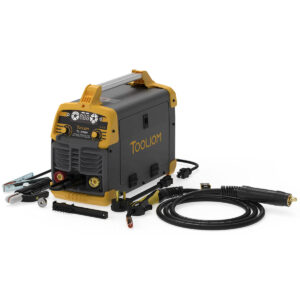

7 Responses
It’s interesting to know that there are basic leather aprons with straps that are in front and around the shoulders. I can imagine how important it would be to invest in quality welding supplies and gear. So I think the employer should be the ones to research and buy the right items they will give to their workers to ensure their safety while working for them.
Hey thanks for your insite.
I agree with you, especially in the work place. Employers should provide the best quality PPE because quality tends to last longer, fit more comfortably, and is safer.
That being said some companies would rather save money and go for the cheaper option which is unfortunately all too common these days
This is simply because welding arcs are more dangerous, and overexposure to its powerful UV rays can peel off your skin or cause a severe skin burn. Therefore, to avoid this, you should always wear a welding jacket during welding for adequate protection.
Yes. I agree.
The best welding shirts is a hazardous activity to do. You do not just deal with harmful fumes and gases from welded materials, but you subject yourself to the likely injury by sparks and heat from the welding machine. Every welder needs to focus on protective gear when performing any welding task. To consider safety as a welder.
https://oursafetysecurity.com/best-welding-shirts/
I have a cousin who’s interested in becoming a professional welder within the next few months and starting his own company in the future. That’s why I think he’d be glad to read your article about welding safety equipment and the importance of wearing it to prevent injuries. Thank you for the information on welder gloves and how they protect you from the heat.
Awesome! I am glad this was helpful. You can also check out what you will need to start welding here https://toolblogtalk.com/what-do-you-need-to-start-welding/ Then you cousin can decide in what welding direction they would like to go. You can look at the different types of welding here. https://toolblogtalk.com/the-different-types-of-welding/